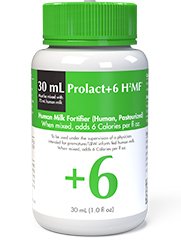Press Releases

Prolacta Bioscience, the nation’s leading provider of human milk-based neonatal nutritional products to hospitals, is introducing a new 15 mL option for its Prolact+6 H2MF® Human Milk Fortifier (Human, Pasteurized), made exclusively from human milk. The new 15 mL volume is an alternative to the standard 30 mL fill. The lower volume enables clinicians to administer a higher-calorie fortifier with more protein to very small premature infants while minimizing costly product waste. Clinicians start feeds for small preterm babies using small volumes and advance them gradually.
This feeding protocol can lead to product waste when the 30 mL volume of Prolact+6 fortifier is mixed with the required quantity of human milk because the mixture must be used within 48 hours from the start of thawing the frozen fortifier. As a result, small infants are often given the lower-concentration Prolact+4 H2MF® fortifier, which is available in a 10 mL volume.
With the new 15 mL volume of Prolact+6 H2MF fortifier, clinicians now have the choice of a higher-concentration fortifier to better support growth in the tiniest premature infants with less waste.
"Healthcare providers are recognizing that it is safe and beneficial to boost the amount of protein and other critical nutrients sooner when feeding very tiny infants," said Prolacta Bioscience President and CEO Scott Elster. "The new 15 mL volume of Prolact+6 fortifier allows for the optimal fortification of smaller-volume feeds, to maintain the proper nutritional balance for these medically fragile preemies without wasting precious fortified human milk nutrition."
Because specialized nutrition is vital to premature infant survival, the American Academy of Pediatrics (AAP) recommends fortifying mother’s own milk or pasteurized donor milk with protein, minerals, and vitamins to ensure optimal nutrient intake for premature babies weighing less than 1500 g (3 lb 5 oz).
When used as part of an exclusive human milk diet (EHMD), Prolact+ H2MF products add calories, protein and minerals, and are clinically proven to improve health outcomes and reduce hospital costs for critically ill, extremely premature infants weighing between 500 and 1250 g (1 lb 2 oz to 2 lb 12 oz) at birth, in the neonatal intensive care unit (NICU), as compared to cow milk-based fortifier or cow milk-based preterm formula.